Ferrets (Mustela putorius furo) are fascinating creatures known for their playful behavior and unique physiology. One of the critical aspects of their biology is their blood cells, which play a significant role in the transport of oxygen throughout their bodies. Understanding the composition and function of ferret blood cells provides insights into how these animals thrive in various environments, as well as highlights evolutionary adaptations that allow efficient oxygen transport. This article delves into the unique characteristics of ferret blood cells, the mechanisms of oxygen binding in hemoglobin, the structural implications for transport efficiency, and a comparative analysis with other mammalian species.
Understanding the Unique Composition of Ferret Blood Cells
The blood of ferrets is composed of various elements, primarily red blood cells (erythrocytes), white blood cells (leukocytes), and platelets, all of which contribute to their overall health and functionality. Ferret erythrocytes are characterized by their elliptical shape and increased surface area, which allows for more efficient gas exchange. This unique morphology is adapted to their active lifestyle, as it enables rapid oxygen uptake during high-energy activities like hunting or playing. Furthermore, ferret red blood cells contain a specific concentration of hemoglobin, the protein responsible for binding and transporting oxygen.
In addition to erythrocytes, ferret blood contains a range of leukocytes that serve vital roles in the immune response. These white blood cells help protect ferrets from various pathogens and diseases, ensuring their well-being in both wild and domestic settings. The composition of these immune cells is essential for the overall health of ferrets, particularly when considering the challenges posed by their environments or dietary habits. This multifaceted cellular composition emphasizes the importance of blood cells in maintaining not only oxygen transport but also the overall homeostasis of the ferret organism.
Finally, platelets in ferret blood are crucial for wound healing and maintaining vascular integrity. When injury occurs, platelets aggregate to form clots, preventing excessive bleeding. This aspect of blood cell function is vital for ferrets, as they experience various physical interactions and potential injuries during their active lifestyles. The unique combination of these blood components demonstrates an intricate system that supports ferrets’ oxygen transport needs while also safeguarding their health.
Mechanisms of Oxygen Binding in Ferret Hemoglobin
Ferrets possess a distinct type of hemoglobin that exhibits specialized properties for oxygen binding. Similar to other mammals, ferret hemoglobin is a tetrameric protein composed of two alpha and two beta chains. However, the specific amino acid composition and structural dynamics of ferret hemoglobin allow for a more efficient binding affinity for oxygen, especially at lower partial pressures. This characteristic is particularly advantageous for ferrets, as it enables them to maintain adequate oxygen levels during periods of high metabolic demand.
The process of oxygen binding occurs via cooperative interactions among hemoglobin subunits. When one oxygen molecule binds to an iron atom within a hemoglobin subunit, it induces a conformational change that increases the affinity of the other subunits for oxygen. This cooperative binding mechanism ensures that ferrets can rapidly saturate their hemoglobin with oxygen during intense activities. Additionally, the physiological factors affecting hemoglobin’s oxygen affinity, such as pH and temperature, play an essential role in optimizing oxygen transport in ferrets.
Moreover, the ferret’s hemoglobin’s ability to efficiently release oxygen to tissues under varying metabolic conditions is critical for their survival and activity levels. This adaptability allows ferrets to thrive in diverse environments, from active play and exploration to periods of rest. Understanding these mechanisms highlights the evolutionary significance of ferret hemoglobin and its optimized function for oxygen transport in relation to their lifestyle.
The Impact of Ferret Blood Cell Structure on Oxygen Transport
The structural characteristics of ferret blood cells significantly influence their efficiency in oxygen transport. The elliptical shape of their erythrocytes is designed for optimal flow through the narrowest capillaries, facilitating effective oxygen delivery to all bodily tissues. This adaptability allows ferrets to engage in dynamic physical activities, as their blood cells can rapidly respond to changing oxygen demands. The increased surface area of their red blood cells also enhances the rate of diffusion, allowing for quicker oxygen exchange in the lungs and tissues.
Additionally, the presence of a higher concentration of hemoglobin within ferret erythrocytes directly correlates with their oxygen-carrying capacity. This adaptation ensures that ferrets can maintain sufficient oxygen levels during periods of intense exercise or stress, which is particularly crucial for a species that exhibits high levels of activity throughout the day. The specific cellular environment within the ferret’s bloodstream is optimized for efficient gas exchange, further contributing to their overall energy metabolism and physical endurance.
Furthermore, the efficiency of oxygen transport is also affected by the dynamics of blood flow and the interaction between blood cells and the vascular system. Ferrets possess a well-developed cardiovascular system that supports rapid circulation, ensuring that oxygen-rich blood reaches tissues effectively. The interplay between the structural attributes of ferret blood cells and their physiological environment underscores the evolutionary adaptations that enable these animals to thrive in various habitats and maintain their playful nature.
Comparative Analysis: Ferrets and Other Mammalian Species
When comparing ferrets to other mammalian species, notable differences emerge in the structure and function of their blood cells, particularly concerning oxygen transport. For instance, the hemoglobin in larger mammals, such as elephants or horses, often has adaptations suited for their size and the demands of their environments. While ferrets have evolved for agility and speed, larger mammals may possess hemoglobin with different binding affinities, tailored to their unique metabolic rates and oxygen requirements.
Moreover, the size and shape of erythrocytes vary among mammals, influencing their oxygen-carrying capabilities. For example, while ferrets have elliptical red blood cells, some species, like humans, have biconcave disc-shaped erythrocytes. This structural variation affects not only the efficiency of oxygen transport but also the flexibility of red blood cells as they navigate through the circulatory system. Understanding these differences highlights the evolutionary pressures that shape blood cell characteristics in response to lifestyle and habitat demands.
Lastly, the presence of other factors, such as altitude and activity level, further diversifies the adaptations found in mammalian blood cells. Species that inhabit high altitudes, such as llamas or certain species of mountain-dwelling mammals, exhibit increased hemoglobin concentration to maximize oxygen uptake. In contrast, ferrets, with their specific adaptations for agility and playfulness, demonstrate how evolutionary adaptations can vary greatly among mammals based on ecological niches, highlighting the intricate relationship between form and function in the animal kingdom.
In conclusion, the blood cells of ferrets play a crucial role in oxygen transport, characterized by unique structural adaptations and mechanisms that enable these animals to thrive in their dynamic environments. Their elliptical red blood cells, the efficient oxygen-binding properties of their hemoglobin, and the overall composition of their blood contribute to their agility and energy levels. A comparative analysis with other mammals reveals the diverse evolutionary adaptations that inform how different species optimize oxygen transport. Understanding these biological intricacies not only enhances our knowledge of ferret physiology but also emphasizes the fascinating interplay between structure, function, and adaptation in the broader context of mammalian life.










